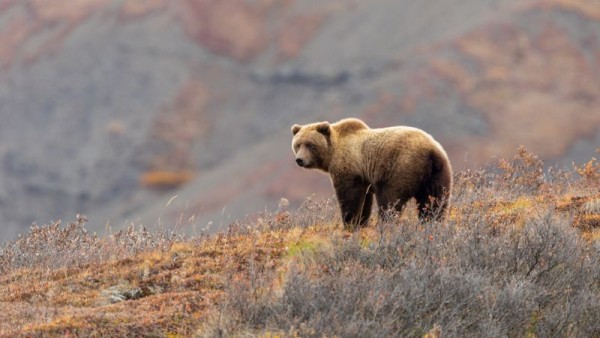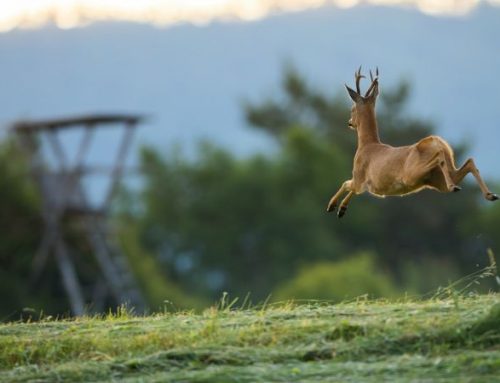There are hunts that belong to another era—adventures steeped in legend and frontier spirit, where the stakes are not just about the trophy but survival itself. Grizzly hunting, the pursuit of the great North American brown bear, is one of them.
Even today, for those bold enough to face it, this hunt embodies the very essence of the wilderness: power, danger, and deep respect for a predator with no equal.
The Grizzly: More Than an Animal, a Symbol of the Wild North America
The grizzly is not just another bear. It is the undisputed ruler of Alaska’s forests, Canada’s mountains, and the vast valleys of the American Northwest. When it walks, it neither flees nor hides. Every sign of its presence—the massive footprints, the claw marks on trees, the raw, untamed scent it leaves behind—tells one undeniable truth: here, it is the master.
Hunting the grizzly means stepping into the territory of an animal that can see you, scent you, and decide whether to ignore you or confront you. And when a grizzly decides to attack, nothing can stop it. It is the perfect predator—brutal strength, endless endurance, intelligence, and courage. A challenge that, even today, separates hunters from mere adventurers.
Grizzly Hunting in History – Between Legend and Survival
For centuries, the grizzly has been both the enemy and the legend of native peoples. The tribes of the Great Plains and the Rocky Mountains spoke of it with both respect and fear. They called it the Mountain Man, believing it to be almost human in strength and intelligence.
Facing a grizzly in the hunt was a test of courage reserved for only the bravest warriors. Some tribes, like the Blackfeet and the Sioux, believed that only those who dared to challenge the grizzly could become a chief or a shaman.
With the arrival of trappers and pioneers, grizzly hunting became a necessity. Its fur was worth its weight in gold, and while its meat was not prized, it was a vital food source during the long winters. But no one was under any illusion—this was no easy hunt. One mistake, one poorly placed shot, and the bear became the hunter.
In the stories of the mountain men, the grizzly was always the most feared enemy. Legends like Hugh Glass—the man who inspired the film The Revenant—owe their fame to terrifying encounters with these giants.
Grizzly Hunting Today – Adventure and Real Danger
Today, grizzly hunting is strictly regulated, permitted only in select areas of Alaska and specific Canadian provinces such as British Columbia and Yukon. Yet, the essence of this challenge remains unchanged: every encounter with a grizzly is a true test, where the margin for error is razor-thin.
The hunt takes place on foot or horseback, across vast, untamed landscapes where nature still reigns supreme. Hunters trek for days, following tracks in the snow or tundra, scanning ridgelines, and listening intently to every sound. The grizzly moves silently, and more often than not, it is the bear who spots the hunter first.
And then comes that moment. When the massive silhouette of the bear stands against the sky, and your heart starts racing. The hunter knows this is not an animal to chase—this is the moment to stop, read the wind, assess every detail. And, most importantly, decide whether to take the shot.
Because making a mistake doesn’t just mean losing the hunt—it means putting your own life at risk.
Technique, Caliber, and Steady Nerves: What It Takes to Face a Grizzly
The grizzly commands respect—even in ballistics. This is no ordinary game animal; the shot must be perfect, and the caliber must be right.
Experienced hunters recommend rifles chambered in .375 H&H, .416 Remington Magnum, .338 Win Mag, or .45-70 for close-range encounters. Controlled-expansion bullets, capable of penetrating thick hide, dense muscle, and heavy bone, are absolutely essential.
Bolt Action Holland & Holland camerata in 375 magnum
But the real weapon is the mind: cold blood, nerves of steel, and the ability to read the situation. A grizzly is often spotted from a distance, but a charge can erupt in an instant, at just a few meters.
It’s not uncommon for the hunt to turn into a chase—or for meat left on the ground to draw a bear in the night, forcing the hunter to stand guard, rifle in hand.
Why the Grizzly Is Different – A Hunt That Changes You
The difference between grizzly hunting and any other form of hunting lies in the perception of real danger. Here, you are no longer the predator—you are just another creature in the food chain. There is no comfort, no routine. There is only the wilderness, in its purest and most untamed form.
Hunting the grizzly is not for those seeking a trophy to display, but for those who crave a true challenge—one fought on equal terms. It is a rite of passage, an experience that leaves a lasting mark on any hunter bold enough to face it.
And when it’s all over—whether you return with a bear or just the memory of the encounter—one feeling lingers: the knowledge that you have walked where few dare to go.
The Grizzly: Master of the North American Wilderness
Massive, powerful, unpredictable—the grizzly is the embodiment of a nature that has no need for man. With its face turned to the wind and its senses always sharp, it moves as the undisputed ruler of valleys, forests, and mountains, from British Columbia to Alaska.
Every sign it leaves behind—huge tracks, deep claw marks on trees, tufts of fur caught in the moss—tells the story of an animal with no rivals.
The Origins of the Myth: Natives, Trappers, and Pioneers
For the Native peoples of the Great Plains and Rocky Mountains, the grizzly was more than just an animal—it was sacred. The Blackfeet, Crow, Sioux, and Shoshone revered it as a symbol of strength and a spiritual guide. Facing one in a hunt was a rite of passage, reserved for only the bravest warriors.
To kill a grizzly earned eternal respect, but before doing so, a hunter first had to ask the bear’s spirit for forgiveness.
With the Arrival of Europeans, Grizzly Hunting Became Legend. The mountain men of the 19th century—figures like Jim Bridger and Grizzly Adams—told stories of brutal battles with these giants, often fought hand-to-hand once their gunpowder ran out. These encounters became legendary, cementing the grizzly’s reputation as the ultimate test of survival in the untamed frontier.
The Grizzly in American Culture: A Symbol That Endures
The grizzly bear found its way onto California’s state seal and the Golden State’s flag, representing independence and strength. Even today, it remains an icon of the American wilderness, embodying the eternal struggle between man and untamed nature.
But the grizzly has also entered our imagination through popular culture and cinema. Films like The Revenant have showcased to the wider public the brutality and power of this animal, recreating the legendary confrontation between Hugh Glass and the bear, one of the most iconic scenes in world cinema.
The Psychology of Grizzly Hunting – When the Hunter Becomes the Prey
Hunting the grizzly is, above all, a mental challenge. Few animals make you feel as vulnerable as this. Here, you are no longer the predator; you are just another piece in the food chain.
Every step through the woods or along a river could turn into a close encounter. You know that a grizzly might see you or smell you before you even realize it’s there. The feeling of being watched by something bigger and more powerful than you stays with you throughout the hunt.
And when you finally see it, when the enormous mass of muscle and fur moves slowly in front of you, you realize that every move must be calculated. There is no room for error, no margin for uncertainty. The adrenaline is pure, and the fear is real.
Technique, Weapons, and Cold Blood: The Toughest Hunt
The grizzly is not an animal to take lightly. You need large-caliber weapons like the .375 H&H, .416 Remington Magnum, .338 Win Mag, and solid projectiles capable of penetrating bones and muscles.
The hunt often takes place on foot, in silence, following tracks through the tundra and mountains. Difficult shots are not uncommon, often taken under pressure while the grizzly moves or notices your presence.
Then there’s the management of the carcass, which can attract other bears within hours. Every stage of the grizzly hunt is a matter of survival.
How to Prepare a Grizzly Hunt Expedition Today
Today, the grizzly hunt is one of the most complex hunting expeditions to organize. You need permits issued by lottery, experienced local guides, and perfect logistics.
You start with heavy backpacks, lightweight tents, and rifles always within reach. The camp is set up in safe areas, far from places where grizzlies go to feed or where female bears with cubs have been sighted.
The best hunting areas remain Alaska, Yukon, and British Columbia, where the grizzly bear still lives freely and without compromise.
In the 19th century, the grizzly was nearly wiped out. Only the vast lands of the North managed to save it from extinction. Today, thanks to wildlife management efforts in both the U.S. and Canada, the species has returned to stable numbers in many areas.
When regulated, grizzly hunting is part of a conservation model: funds from hunting licenses help finance research and habitat protection projects. Paradoxically, it is also thanks to hunting that the grizzly continues to reign over its mountains today.
The Grizzly in Cinema: From Legend to the Big Screen
No other North American animal has inspired cinema like the grizzly. In addition to the already mentioned iconic scene from The Revenant, the bear stars in films like Grizzly (1976), Into the Wild, and documentaries such as The Grizzly Man, the true story of Timothy Treadwell, an environmentalist who lived for years among the bears of Alaska until the tragic conclusion.
The grizzly on screen has always symbolized untamed nature, danger, and an ancestral challenge. Today, grizzly hunting is one of the last bastions of the great North American adventure. An experience that combines history, culture, and adrenaline. A dive into the very wilderness that saw Native Americans bow before the power of the bear, and pioneers tremble behind a veil of smoke.
Because, ultimately, grizzly hunting is this: a test of courage, a challenge with oneself and with the truest form of nature. An experience that marks you, and once lived, it is never forgotten.














